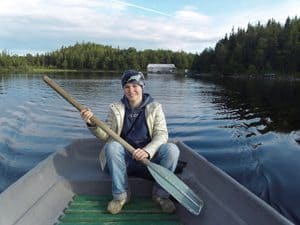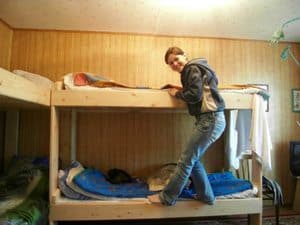Solovetsky Islands: The Silence of the Russian North
By Maria Kozyreva

When planning our summer trip, I offered my husband a chance to visit the Solovetsky Islands.
It was my unrealized dream to see this remote sacred place in the Russian north. The dream was so desirable that I could hardly believe that one day it would come true.
The Solovetsky Islands (or simply Solovki) is not a luxurious resort with stunning hotels and dissimilar tourist attractions. In the course of history, Solovki was known for its fabulous severe nature and its great monastery, a real stronghold of orthodox Christianity. Formerly Solovki had symbolized nothing but asceticism, faith, and spirituality.
Everything changed in 1930-ties when one of the most sacred places in Russia turned into a bloody prison and torture place for millions of Russian people…
Seaport
My mood changed as soon as we got off the train in seaport Kem that is located on the shores of the White Sea, separating Solovetsky Islands from the land.
It was 7 a.m. It was drizzling. Gloomy grey clouds were hanging over the cold leaden sea. The atmosphere was rather depressing but we were ready for it. In an hour our boat “Vasiliy Kosyakov” was to deliver us to the Islands. People on the shore were nervous.
It was rather cold and windy. I looked around and tried to be positive but there was nothing romantic or joyful about Kem. Seventy years ago this town served as a transit camp and administration of the Solovetsky prison. The majority of wooden buildings in the city were built by prisoners.

In the search of the house…
It took almost four hours for “Vasiliy Kosyakov” to deliver us to the Islands. On the shore, we were surrounded by a crowd of locals (among them were lots of babushkas) offering accommodation at moderate prices.
Firstly we were a bit surprised by the low rental costs. That aroused my suspicious and I decided to ask about conditions in “cheap” rooms. It turned out that some of them lacked baths, although in certain cases they were replaced by Russian banyas (or saunas).
More Civilized
My husband who was particularly concerned about comfort insisted that we found something “more civilized”. Sure if we booked hotels beforehand, there would be no problem but our family prefers vacation trips to organized tours.
To cut the story short, there are three ways to find a room in Solovki: on the shore (where we met babushkas), in the tourist office in the center of the Islands and … knocking at the doors. We preferred the third variant.
Our task was to knock at the doors of private houses and ask for accommodation. Thus we got to know Volodya. He offered us his daughter’s room for four persons that he used to lodge in summer in high season.
The room decorated with hand-made dolls and dry flowers looked smart and cozy. As soon as we accepted Volodya’s offer, he mentioned that we would have to share the room with another two tourists, our compatriots Olga and Alexander from Moscow. It didn’t upset us as we knew nobody in the Islands and new company was most welcome for us.
Solovetsky Monastery
The first thing one sees when approaching the Islands by boat is domes of the Solovetsky Monastery. Its huge fortified walls, constructed of enormous dark stones; towers, and orthodox crosses on the domes are associated with selfless labor of people who built this enormous monastery in the severe weather conditions of the Russian North.
Our guide Anna, a friendly smiling girl whom we met in a tourist office, showed us around the Monastery citadel protected by numerous cannons concealed in loopholes of fortified walls.
 I saw with my own eyes modest but roomy refectory where monks gathered to pray and share a meal. I adored huge cast-iron bells located on a wooden pedestal in a monastery yard so that anyone can look at them and even take a photo.
I saw with my own eyes modest but roomy refectory where monks gathered to pray and share a meal. I adored huge cast-iron bells located on a wooden pedestal in a monastery yard so that anyone can look at them and even take a photo.
The last site Anna showed us was the SLON museum that made us plunge into a dark and humiliating history of our country…
SLON
“Slon” is a Russian abbreviation of Solovki Special Purpose Camp. It is a dreary wordplay as in Russian “slon” also means “an elephant”. I asked Anna why a majority of buildings in the Islands are so alike. Dark brownish wooden houses seem to be so cheerless and hostile…
“Actually wooden houses you see here and there are hut barracks built by prisoners like those huts you saw in Kem. Some citizens build modern cottages or repair their old houses, others continue living in lodging constructed by convicts ”.
Founded in 1923, for the first seven-year the number of SLON prisoners grew from 3 to 60 thousand people. Thanks to cheap manpower Soviet government started to export lumber, peat and stone extracted by prisoners (often innocent people, the intellectuals and clergy persecuted by the ruling class). When some countries found out that the imported materials they bought were produced by thousands of prisoners kept in inhuman conditions, they rejected to purchase them.
In 1936 SLON was renamed as “Solovetsky Special Purpose Prison” or STON that sounded as “moan” in Russian, one more dreadful wordplay… It was only in 1939 when SLON was closed.
The mystery of the Russian North
The other day we decided to scatter gloomy thoughts about Solovki prison, to rent a boat and enjoy numerous lakes connected to each other by narrow canals. A boat station was a bit far away from our settlement so Volodya offered us to rent bikes. We followed his advice without hesitation and in half an hour were already racing against each other along a sandy road weaving between mingled woods.

Finally, we reached a small boat station that looked like a modest hut hidden by lush vegetation. There we got to know a boat warden who showed us his boats after a short instruction and warning to be careful.
Lake water was absolutely still. It was hard to believe that there’s any fish. The only living creature we noticed while rowing our small boat was a lonely seagull.
It flew above our heads and landed gracefully on the water in the hope of getting some bread or corn. Unfortunately, we could offer nothing to it and disappointed gull left us without even saying good-bye.
I remember nothing but mirror lake, deep blue sky that in a half an hour became iron-grey, dense green forests on the shore and profound silence. The day was coming to an end. We returned to our settlement and walked down to the White Sea bay.
Crystal blue sky merged into light water. Huge stones scattered on the shore were covered with dense moss and reindeer lichen. Again you hear nothing but silence that makes one feel the beauty of the Russian North and notice its lordly grandeur and mystery.
 Maria Kozyreva graduated from the Peoples’ Friendship University of Russia (Moscow) where she received a specialization of English, French, and as a Spanish interpreter. She also finished journalist courses, won two Regional Journalism Competitions Now she works as a freelance translator and journalist.
Maria Kozyreva graduated from the Peoples’ Friendship University of Russia (Moscow) where she received a specialization of English, French, and as a Spanish interpreter. She also finished journalist courses, won two Regional Journalism Competitions Now she works as a freelance translator and journalist.
- These 9 U.S. National Parks Require Reservations in 2024 - April 17, 2024
- Take a Hike in Olympic National Park - April 17, 2024
- The Wild Mississippi: 2340 Miles Across Ten States - April 8, 2024



Hi,
I was wondering about ‘moderate’ price range for the local host. What is considered moderate for that island (online everything seems to be too expensive for the value)
Thanks (I will be travelling with my 3 kids so I need more than one bed)
Tania